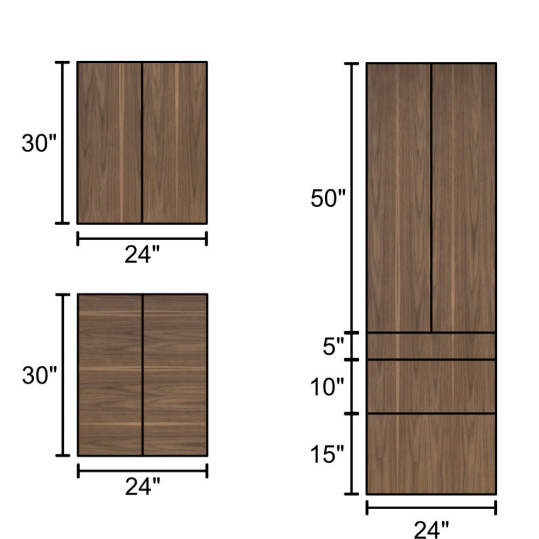Grain Matching FAQ
As an upgrade, we offer grain matching for our #125 veneered flat slab doors. We get a lot of questions about how we do grain matching. This page was put together to try and address some of those questions.
So, what do we mean be grain matching?
Where there are multiple doors on a single cabinet, we will make our best effort to cut the sheet goods that your doors are made from so that the grain pattern is continuous - with a few exceptions.
(Below we have a few acceptable examples of how this might look. On the left we have two standard cabinets, one in vertical grain and the other in horizontal. On the right we have an 80" tall pantry cabinet in vertical grain. As you read on, you will discover why horizontal grain matching goes beyond our standard material constraints.)

If there is ever a reason why we may not be able to do this, we will discuss options with you before financially committing you to the upgrade. An example of an instance where we are unable to match grain across a single cabinet is if our sheet goods (which are 48" x 96" with the grain running the long way) aren't big enough to fit the entire cabinet face worth of fronts in its workable area (i.e. A customer requests horizontal grain matching and the cabinet is 24" wide by 90" tall. At most our sheet goods, with their grain pattern running horizontally, can usually only accommodate for a 48" tall cabinet.) We have a few ways we can remedy such an instance, such as sourcing our material from a specialty supplier or by creating a single door with multiple panels glued together (note: A small seam will be present in the door if this is the route we take.) Any time we need to do something unique to work around our material constraints, the cost of these materials may need to be adjusted accordingly.
What does grain matching cost?
Vertical Grain Matching: 40% increase in material cost*
Horizontal Grain Matching: 60% increase in material cost*
*Material cost is the price of the materials used to make the doors only. This does not include the labor, design, finishing, or shipping costs associated with your doors.
Why does grain matching cost so much more?
In a manufacturing environment, some mistakes are inevitable. We are always working on ways to reduce defects and we're always checking our work so that we can fix or replace these defects before the customer ever gets their hands on them. Nonetheless, we are forced to address the likelihood that these mistakes inevitably do occur, as well as the cost of fixing them. When manufacturing mistakes occur or when material defects are discovered, it is often-times necessary to replace the item. Since grain-matched doors are perfectly matched to the doors and drawer fronts around it, it is then necessary to replace ALL of the doors and drawer fronts in the matched set. Moreover, in the real world, accidents happen after your doors leave our shop as well. It is not unheard-of for items to become damaged in shipping or dropped by an installer - things happen! We have a history of bending-over backwards for our customers and making replacements right away that are usually free of cost to them unless there is a clear "at-fault" party (be sure to read the warranties and agreements!) As such it becomes a huge financial hit and sometimes can wipe out our profit margin altogether on a job when replacements need to get made - especially with grain-matched items!
What about grain-matching neighboring cabinets?
Whenever it is possible to do so, and if it is within the normal constraints of our material sizes, we will go ahead and match nearby cabinets together. Again, this is only possible (at this price point), within 48" x 96" segments. If you have a preference on which cabinets are matched, within the aforementioned constraints, you will need to work with one of our sales associates to establish how this matching takes place. A drawing is usually made up and shared with the customer that is then approved and kept on hand for the carpenters in our shop and for our records. At this price point we can not make any sort of guarantees about being able to match cabinets beyond these 48" x 96" segments or outside of what is communicated by our sales associates. We are always looking for ways to improve our production methods and our material sourcing, but for now, this is all that we can guarantee.
What about grain-matching throughout my entire project?
On occasion, though not always, we are lucky enough to have a few sequentially matching 48" x 96" sheets in our veneered sheet good deliveries. Because of this, we are sometimes able to match a few segments in a run of neighboring cabinets. This is something that we already try to do by default, within reason. We won't completely take apart our stack of materials and find the best possible matches for every customer - if we did we'd have to substantially raise the prices of our doors. If somethings looks drastically different, we may reject the piece or pieces and find a closer match. This is real wood we're dealing with and so we are not able to guarantee sequentially matching cabinets throughout an entire project at this price point. The frequency with which enough matching sheets for an entire project occur in our deliveries is sporadic and not reliable in such a normal or even a 'select' grade of materials. To make any sort of guarantee or assurance that all of the veneered doors, drawer fronts, and panels in an entire project match together would require having the sheet goods custom veneered for your job. Ordering specialty veneered materials can become very expensive and are often associated with paying not only for the materials themselves but also for the shipment of those materials from outside of our normal group of suppliers.
Will the hardwood fillers, trim, and molding match the veneered doors in my project?
It is unlikely that the hardwood items will look exactly like the veneered products. This is real wood we're dealing with. Not only is our hardwood sourced from a different supplier, they are cut from the raw timbers in a completely different way. There are some species and types of cuts that will yield a closer match (i.e. Alder, Ash, Beech, Birch, Cherry, Hickory, Maple, Red Oak.) Species of wood that are known for being difficult to match include Fir, Mahogany, and Walnut.
.png)




